Mongena Lodge Game Walk amongst the Big Five! Part 3
Game Walk.
I had to get up somewhat earlier for this one. I could hardly sleep the night before as I was very excited and the thought of walking amongst the big five on foot really appealed to me.
 As I step out our chalet I was greeted with this sight. Hubby used my cell phone to capture me and the Zebra. These little dude, the dung beetle was not to be out done either!!
As I step out our chalet I was greeted with this sight. Hubby used my cell phone to capture me and the Zebra. These little dude, the dung beetle was not to be out done either!!
Dung beetles are beetles that feed partly or exclusively on dung or feces. They have exceptio dung disposal capacity, which considering what they do all day is a good thing!. The can bury dung 250 times heavier than itself just in one night. That is a lot of poop!! Not all dung beetles eat poop, but they are quiet choosy and don't just eat any poop, but prefer the poop of herbivores as its has more nutritional value to them than that of carnivores.

Not all dung beetles roll their poop trtreasuresnto a neat ball either, some live in the poop pile, like cow patties, or simply bury themselves under the pile of poop and pop up when in need. They take the poop back primarily to feed their young. The females lay a separate egg in its own dung ball. when the little guys hatch food is on tap and they can grow in a safe environment within the nest, The female largely takes care of the little ones, however dad does play an active role. The African dung beetles uses the Milky way to help is navigate in a straight line, how cool is that, that have even been found "dancing" on their ball of poop to get their bearings before the haul their ball of poop. On a hot African day when the sun is beating down at around noon, these little guys they will climb on top of their poop to cool off and give their tiny feet a rest.
 Take a look at my blog on my encounter with Zebras: Patterns in the grass where I write about the unique stripes and their significance in the heard.
Take a look at my blog on my encounter with Zebras: Patterns in the grass where I write about the unique stripes and their significance in the heard.




After we came back in time for a scrumptious breakfast the groom, my mate Thomas who is also the owner of Highveld Taxidermists informed me rather calmly and with somewhat glee that if a lion, or a few had indeed come for us that the rangers rifle a single bolt (what ever that means but it sounded significant) would not have been very effective as the ranger would more than likely not have time to reload before the big bite. Well, I was very relieved to be back in one piece, would I do it again knowing this rather important information. Hell yes!
We walked slowly and quietly through the bush, the air crisp and morning dew heavy on the ground. I could hear a lot of rustling around in the bushes. The great thing about being on foot is that you get up really close to nature and spot the small, yet equally exciting animals, plants and life that you would normally miss sitting in the vehicles. We did not come across any of the big five other than some spoor. We spotted spoor from a honey badger as well as several jackals, buck, warthog.
while walking along the dusty road our first customer for the day was "delta" the wildebeest. I called him "delta" because of the way he moved in stealth mode through the long grass and was so hard to follow. He was a really sneaky bugger!!
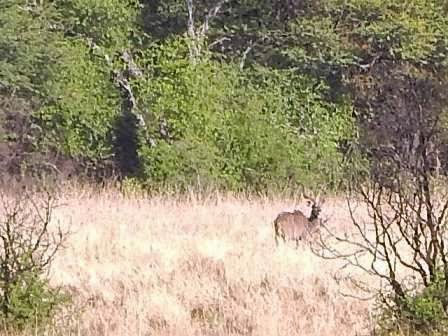.JPG)
It the distance I caught some movement and through my camera a Nikon coolpix L820 I was able to get a close up and identify this beautiful solitary buck, a Kudu!.
.JPG)
The rangers were very knowledgeable and I learned so much about the plants and vegetation, many I come across while hiking.
.JPG)
There were many insects and spiders out in the early morning and it was fascinating watching them.
.JPG)
.JPG)
from a distance I spotted something very white in the bushes and alerted the rangers. We went to investigate and came across the bones of a giraffe. the rangers though she may have been stuck by lightening. They were able to tell that it was a female due to the shape of the bones..JPG)
.JPG)
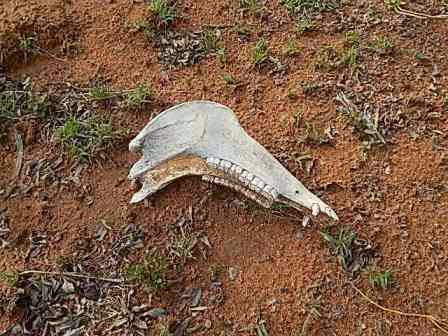.JPG)
.JPG)
one we hand inspected the bones and received a lesson in the awesome giraffe and had all been awestruck at its huge teeth we continued on our journey.
.JPG)
This shot of the dung beetle was not clear but we found many along the way of all sizes!
.JPG)
and then my favorite "Pumba" the warthogs. We came across many tunnels and we were told of many stories of people getting injured getting too close to the entrance as the warthogs with their very effective tusks ramming into you causing severe damage. So we stood a safe distance and above to see if there was any activities or inhabitants. but our luck was out, no one would be charged today! In some of the places we found several of these tunnels grouped together like a colony. I love these little guys and have a leather lounge suit at home that still has tusk markes of a baby warthog that was hand reared after its mother had died
.JPG)
further along we came across another one of my favorites, the Songolo. This one was huge and I dont recall seeing one this big. I found out later that there is the Giant African Songolo and today i had come across one of these magnificent centipedes.
.JPG)
.JPG)
.JPG)
.JPG) In a previous blog I wrote about this little Milliped. The songololo or Shongolo, its name for the Nguni ukusonga, meaning to roll up or to fold. they have between 36 to 400 legs. When picked up they will leave an awful smell and a brownish stain on your skin that is difficult to get off. When in danger they secrete hydrocyanic acid which repels predators. Also secreted is alkaloids, benzoquinones, phenols, terpenoids and others. Some of these are caustic and can burn the exoskeleton of ants and other insect predators and the skin and eyes of larger predators, like us.
In a previous blog I wrote about this little Milliped. The songololo or Shongolo, its name for the Nguni ukusonga, meaning to roll up or to fold. they have between 36 to 400 legs. When picked up they will leave an awful smell and a brownish stain on your skin that is difficult to get off. When in danger they secrete hydrocyanic acid which repels predators. Also secreted is alkaloids, benzoquinones, phenols, terpenoids and others. Some of these are caustic and can burn the exoskeleton of ants and other insect predators and the skin and eyes of larger predators, like us.
.JPG)

Primates such as Capuchin Monkeys and lemurs have actually be spotted intentionally irritating them to rub the chemicals onto themselves to use as a mosquito repellent!!

They do not bite or sting!! they eat mostly decaying vegetations and ants. they will shed as they grow and lay between 10 and 300 eggs.

we were a small group and many were keen birders so all the bird calls were identified and logged. It was great fun!
.JPG)
.JPG)
.JPG)
.JPG)
We explored in the tiniest of places and during our explorations, while walking along this road we came across these tiny little red "spiders". they seemed to be part spider and part crab! They came out from little burrows in the road and had a bright red velvet looking "coat". I later found out that they were known as the "christmas spider" and are associated with Christmas, because of its red velvety appearance which resembles the traditional red outfit worn by Santa Claus!
 We are told that local people believe their origin is heaven and they drop from the heavens above just before Christmas. They are known by many names in different countries. In Botswana they are known as modimo (god) and in Tanzania mwamba (the child of rain).
We are told that local people believe their origin is heaven and they drop from the heavens above just before Christmas. They are known by many names in different countries. In Botswana they are known as modimo (god) and in Tanzania mwamba (the child of rain).
This little creature is not actually a spider but a mite, both are members of an eight-legged 'non-insects" group called Arachnida, which include scorpions and ticks. Being mites they emerge from the soil soon after heavy rains and this was exactly what was happening. the ground still wet from the several thunder storms we had had all weekend. These little guys are commonly found in the more sandy areas.They emerge from the soil once a year at the end of the dry season.
They only have a few hours to look for food and mate before they burrow back into the soil where they spend their life as parasites attached to other insects in the larval stage and as predators of insects and non-insects in the adult stage. Even though my photo is somewhat blurred you ca make out all the tiny burrows around the red blob!(I found some photos on google and added them. They are known to be cannibalistic and feed on other mites and their eggs. They don't seem to have predators and their bodies produce both antifungal and antibacterial oils making them unpalatable.

 In Southern Africa its official name is the Red Velvet Mite, belonging to the mite genus Dinothrombium. They are very beneficial to our ecosystem acting as biological control agents removing unwanted grasshoppers, treehoppers, termites, beetles, spider mites, playing a large role in the recycling of nutrients found in the soil. In India and other countries, extracts from the Red Velvet mites had been used to treat paralysis, boost immune systems and to enhance libido. In saying this please do not try this out for yourself!!
In Southern Africa its official name is the Red Velvet Mite, belonging to the mite genus Dinothrombium. They are very beneficial to our ecosystem acting as biological control agents removing unwanted grasshoppers, treehoppers, termites, beetles, spider mites, playing a large role in the recycling of nutrients found in the soil. In India and other countries, extracts from the Red Velvet mites had been used to treat paralysis, boost immune systems and to enhance libido. In saying this please do not try this out for yourself!!
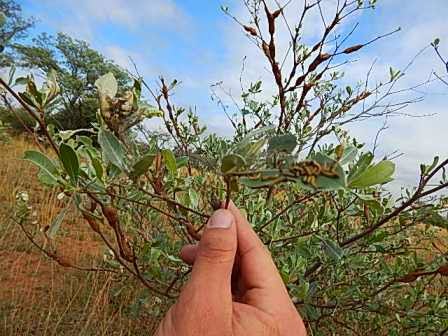.JPG)
we came across these tiny little caterpillars. You can see them on the leaf to the right of the rangers hand.
.JPG) this little nest with eggs turned out to be a turtle doves little home. Was so cool to see it out in the wild!
this little nest with eggs turned out to be a turtle doves little home. Was so cool to see it out in the wild!
.JPG)
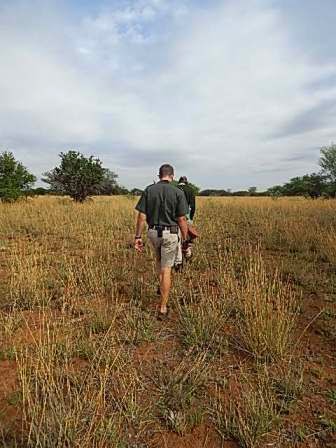.JPG)
and then we spotted him "Pumba"
.JPG)
.JPG)
.JPG)
We then walked to the lake. The birdlife was in abundance and the scenery as the storm clouds hovered, dramatic.
.JPG)
.JPG)
.JPG)
I loved the colours and reflections on the water and I was having a lot of fun with my new camera, still working it out so I did miss out on some really great shots!
.JPG)
and then we were in for a treat!! A water monitor lizard - here in South Africa we call them leguaans or we commonly use the local Afrikannas name "likkewaan, suddenly exploded out from some undergrowth and dived into the lake and I was able to capture him now taking a cautious but leisurely swim.
we was a bute - look at the size of him - absolutely stunning!
.JPG)
The Monitor Lizard is the common name of several large lizard species comprising of the genus Varanus. These guys are native to Africa, Asia and even Oceania, but have invaded the Americas and are therefore considered as an invasive species.
Monitor Lizards have really long necks, a powerful tail and strong legs with claws. an adult can grow from 20cm to well over 3m depending on the species, like the Komodo dragon. some extinct varanid have grown to as much as 7m.
They are terrestrial, but some are arboreal and semi-aquatic. Most are carnivorous, eat eggs, smaller reptiles, fish, birds and small mammals, but some also eat fruit and vegetation depending on their environment.
.JPG)
Currently around 77 species are recognized. but more research needs to be done on this awesome creature that kept me fascinated for some time.
.JPG)
loved the forever changing colours of the water!!
.JPG)
.JPG)
.JPG)
.JPG)
we had some hot coffee and a wrap up and then the Land Rover arrived to take us back to the lodge, just in time for breakfast as light rain began to fall.
.JPG)
the egrets were very busy indeed!!
.JPG)
.JPG)
.JPG)
.JPG)
.JPG)
.JPG)
.JPG)
.JPG)
.JPG)
.JPG)
.JPG)
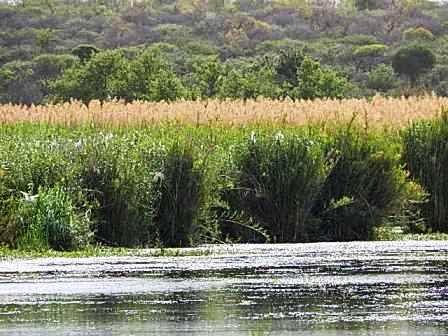.JPG)
.JPG)
.JPG)
.JPG)
.JPG)
.JPG)
.JPG)
.JPG)
.JPG)
.JPG)
.JPG)
.JPG)
on the way back we came across some gamel
.JPG)
.JPG)
.JPG)
.JPG)
.JPG)
and then it was back to reality after a hearty breakfast, fond farewells to all the wedding guests and old friends.

I had to get up somewhat earlier for this one. I could hardly sleep the night before as I was very excited and the thought of walking amongst the big five on foot really appealed to me.
 As I step out our chalet I was greeted with this sight. Hubby used my cell phone to capture me and the Zebra. These little dude, the dung beetle was not to be out done either!!
As I step out our chalet I was greeted with this sight. Hubby used my cell phone to capture me and the Zebra. These little dude, the dung beetle was not to be out done either!!Dung beetles are beetles that feed partly or exclusively on dung or feces. They have exceptio dung disposal capacity, which considering what they do all day is a good thing!. The can bury dung 250 times heavier than itself just in one night. That is a lot of poop!! Not all dung beetles eat poop, but they are quiet choosy and don't just eat any poop, but prefer the poop of herbivores as its has more nutritional value to them than that of carnivores.

Not all dung beetles roll their poop trtreasuresnto a neat ball either, some live in the poop pile, like cow patties, or simply bury themselves under the pile of poop and pop up when in need. They take the poop back primarily to feed their young. The females lay a separate egg in its own dung ball. when the little guys hatch food is on tap and they can grow in a safe environment within the nest, The female largely takes care of the little ones, however dad does play an active role. The African dung beetles uses the Milky way to help is navigate in a straight line, how cool is that, that have even been found "dancing" on their ball of poop to get their bearings before the haul their ball of poop. On a hot African day when the sun is beating down at around noon, these little guys they will climb on top of their poop to cool off and give their tiny feet a rest.
 Take a look at my blog on my encounter with Zebras: Patterns in the grass where I write about the unique stripes and their significance in the heard.
Take a look at my blog on my encounter with Zebras: Patterns in the grass where I write about the unique stripes and their significance in the heard.



After we came back in time for a scrumptious breakfast the groom, my mate Thomas who is also the owner of Highveld Taxidermists informed me rather calmly and with somewhat glee that if a lion, or a few had indeed come for us that the rangers rifle a single bolt (what ever that means but it sounded significant) would not have been very effective as the ranger would more than likely not have time to reload before the big bite. Well, I was very relieved to be back in one piece, would I do it again knowing this rather important information. Hell yes!
We walked slowly and quietly through the bush, the air crisp and morning dew heavy on the ground. I could hear a lot of rustling around in the bushes. The great thing about being on foot is that you get up really close to nature and spot the small, yet equally exciting animals, plants and life that you would normally miss sitting in the vehicles. We did not come across any of the big five other than some spoor. We spotted spoor from a honey badger as well as several jackals, buck, warthog.
while walking along the dusty road our first customer for the day was "delta" the wildebeest. I called him "delta" because of the way he moved in stealth mode through the long grass and was so hard to follow. He was a really sneaky bugger!!
.JPG)
It the distance I caught some movement and through my camera a Nikon coolpix L820 I was able to get a close up and identify this beautiful solitary buck, a Kudu!.
.JPG)
The rangers were very knowledgeable and I learned so much about the plants and vegetation, many I come across while hiking.
.JPG)
There were many insects and spiders out in the early morning and it was fascinating watching them.
.JPG)
.JPG)
from a distance I spotted something very white in the bushes and alerted the rangers. We went to investigate and came across the bones of a giraffe. the rangers though she may have been stuck by lightening. They were able to tell that it was a female due to the shape of the bones.
.JPG)
.JPG)
.JPG)
.JPG)
one we hand inspected the bones and received a lesson in the awesome giraffe and had all been awestruck at its huge teeth we continued on our journey.
.JPG)
This shot of the dung beetle was not clear but we found many along the way of all sizes!
.JPG)
and then my favorite "Pumba" the warthogs. We came across many tunnels and we were told of many stories of people getting injured getting too close to the entrance as the warthogs with their very effective tusks ramming into you causing severe damage. So we stood a safe distance and above to see if there was any activities or inhabitants. but our luck was out, no one would be charged today! In some of the places we found several of these tunnels grouped together like a colony. I love these little guys and have a leather lounge suit at home that still has tusk markes of a baby warthog that was hand reared after its mother had died
.JPG)
.JPG)
.JPG)
.JPG)
.JPG) In a previous blog I wrote about this little Milliped. The songololo or Shongolo, its name for the Nguni ukusonga, meaning to roll up or to fold. they have between 36 to 400 legs. When picked up they will leave an awful smell and a brownish stain on your skin that is difficult to get off. When in danger they secrete hydrocyanic acid which repels predators. Also secreted is alkaloids, benzoquinones, phenols, terpenoids and others. Some of these are caustic and can burn the exoskeleton of ants and other insect predators and the skin and eyes of larger predators, like us.
In a previous blog I wrote about this little Milliped. The songololo or Shongolo, its name for the Nguni ukusonga, meaning to roll up or to fold. they have between 36 to 400 legs. When picked up they will leave an awful smell and a brownish stain on your skin that is difficult to get off. When in danger they secrete hydrocyanic acid which repels predators. Also secreted is alkaloids, benzoquinones, phenols, terpenoids and others. Some of these are caustic and can burn the exoskeleton of ants and other insect predators and the skin and eyes of larger predators, like us..JPG)

Primates such as Capuchin Monkeys and lemurs have actually be spotted intentionally irritating them to rub the chemicals onto themselves to use as a mosquito repellent!!

They do not bite or sting!! they eat mostly decaying vegetations and ants. they will shed as they grow and lay between 10 and 300 eggs.

we were a small group and many were keen birders so all the bird calls were identified and logged. It was great fun!
.JPG)
.JPG)
.JPG)
.JPG)
We explored in the tiniest of places and during our explorations, while walking along this road we came across these tiny little red "spiders". they seemed to be part spider and part crab! They came out from little burrows in the road and had a bright red velvet looking "coat". I later found out that they were known as the "christmas spider" and are associated with Christmas, because of its red velvety appearance which resembles the traditional red outfit worn by Santa Claus!
 We are told that local people believe their origin is heaven and they drop from the heavens above just before Christmas. They are known by many names in different countries. In Botswana they are known as modimo (god) and in Tanzania mwamba (the child of rain).
We are told that local people believe their origin is heaven and they drop from the heavens above just before Christmas. They are known by many names in different countries. In Botswana they are known as modimo (god) and in Tanzania mwamba (the child of rain).This little creature is not actually a spider but a mite, both are members of an eight-legged 'non-insects" group called Arachnida, which include scorpions and ticks. Being mites they emerge from the soil soon after heavy rains and this was exactly what was happening. the ground still wet from the several thunder storms we had had all weekend. These little guys are commonly found in the more sandy areas.They emerge from the soil once a year at the end of the dry season.
They only have a few hours to look for food and mate before they burrow back into the soil where they spend their life as parasites attached to other insects in the larval stage and as predators of insects and non-insects in the adult stage. Even though my photo is somewhat blurred you ca make out all the tiny burrows around the red blob!(I found some photos on google and added them. They are known to be cannibalistic and feed on other mites and their eggs. They don't seem to have predators and their bodies produce both antifungal and antibacterial oils making them unpalatable.

 In Southern Africa its official name is the Red Velvet Mite, belonging to the mite genus Dinothrombium. They are very beneficial to our ecosystem acting as biological control agents removing unwanted grasshoppers, treehoppers, termites, beetles, spider mites, playing a large role in the recycling of nutrients found in the soil. In India and other countries, extracts from the Red Velvet mites had been used to treat paralysis, boost immune systems and to enhance libido. In saying this please do not try this out for yourself!!
In Southern Africa its official name is the Red Velvet Mite, belonging to the mite genus Dinothrombium. They are very beneficial to our ecosystem acting as biological control agents removing unwanted grasshoppers, treehoppers, termites, beetles, spider mites, playing a large role in the recycling of nutrients found in the soil. In India and other countries, extracts from the Red Velvet mites had been used to treat paralysis, boost immune systems and to enhance libido. In saying this please do not try this out for yourself!!.JPG)
we came across these tiny little caterpillars. You can see them on the leaf to the right of the rangers hand.
.JPG) this little nest with eggs turned out to be a turtle doves little home. Was so cool to see it out in the wild!
this little nest with eggs turned out to be a turtle doves little home. Was so cool to see it out in the wild!.JPG)
.JPG)
and then we spotted him "Pumba"
.JPG)
.JPG)
.JPG)
We then walked to the lake. The birdlife was in abundance and the scenery as the storm clouds hovered, dramatic.
.JPG)
.JPG)
.JPG)
I loved the colours and reflections on the water and I was having a lot of fun with my new camera, still working it out so I did miss out on some really great shots!
.JPG)
and then we were in for a treat!! A water monitor lizard - here in South Africa we call them leguaans or we commonly use the local Afrikannas name "likkewaan, suddenly exploded out from some undergrowth and dived into the lake and I was able to capture him now taking a cautious but leisurely swim.
we was a bute - look at the size of him - absolutely stunning!
.JPG)
The Monitor Lizard is the common name of several large lizard species comprising of the genus Varanus. These guys are native to Africa, Asia and even Oceania, but have invaded the Americas and are therefore considered as an invasive species.
Monitor Lizards have really long necks, a powerful tail and strong legs with claws. an adult can grow from 20cm to well over 3m depending on the species, like the Komodo dragon. some extinct varanid have grown to as much as 7m.
They are terrestrial, but some are arboreal and semi-aquatic. Most are carnivorous, eat eggs, smaller reptiles, fish, birds and small mammals, but some also eat fruit and vegetation depending on their environment.
.JPG)
Currently around 77 species are recognized. but more research needs to be done on this awesome creature that kept me fascinated for some time.
.JPG)
loved the forever changing colours of the water!!
.JPG)
.JPG)
.JPG)
.JPG)
we had some hot coffee and a wrap up and then the Land Rover arrived to take us back to the lodge, just in time for breakfast as light rain began to fall.
.JPG)
the egrets were very busy indeed!!
.JPG)
.JPG)
.JPG)
.JPG)
.JPG)
.JPG)
.JPG)
.JPG)
.JPG)
.JPG)
.JPG)
.JPG)
.JPG)
.JPG)
.JPG)
.JPG)
.JPG)
.JPG)
.JPG)
.JPG)
.JPG)
.JPG)
.JPG)
on the way back we came across some gamel
.JPG)
.JPG)
.JPG)
.JPG)
.JPG)
and then it was back to reality after a hearty breakfast, fond farewells to all the wedding guests and old friends.

Warmest yours in adventure!





.JPG)
.JPG)
.JPG)
.JPG)
.JPG)
.JPG)
.JPG)
.JPG)
.JPG)
.JPG)

.JPG)
.JPG)
.JPG)
.JPG)

.jpg)
.JPG)
.JPG)
.JPG)
.JPG)
.JPG)
.JPG)
.JPG)
.JPG)
.JPG)
.JPG)
.JPG)
.JPG)
.JPG)
.JPG)
.JPG)
.JPG)
.JPG)
.JPG)
.JPG)
.JPG)
.JPG)
.JPG)
.JPG)
.JPG)
.JPG)
.JPG)
.JPG)
.JPG)
.JPG)
.JPG)
.JPG)
.JPG)
.JPG)
.JPG)
.JPG)




